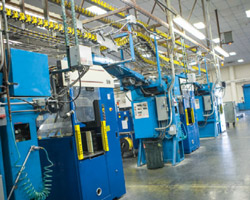
Posted to News on 20th Nov 2017, 09:05
Benefits of using 'smart' connectors for identification
Ralf Reicks, a Product Manager at Harting Technology Group, explains how 'smart' connectors are starting to be used for a wider variety of identification tasks.

Besides the identification of components and machine elements, 'smart' connectors are also increasingly being deployed in predictive maintenance. Communication can be performed using inexpensive bidirectional systems like the I2C bus, as well as standardised bus systems such as CAN-Bus and all the way through to Ethernet profiles like Profinet. In addition to the already established ID module, the new CAN ID Module is the latest product in the smart Han series - and is now making a name for itself.
Implementation as a Han Modular module ensures that identification is flexibly integrated into interfaces which comprehensively supply machines with power, data and signals, but without taking up much space. The progress made by transferring identification functionality to the connector can best be illustrated by differentiating between processing machinery intended for mobile use and machinery with isochronous drives.
Case 1: Mobile processing machinery with interchangeable elements

Information such as the year of manufacturing, the last revision status and other parameters of the machine unit can also be stored and used for predictive maintenance on the application. In this case, the ID Module has a double function as an identification tool and data memory.
Customers benefit from the fact that erroneous insertion of a machine unit is prevented. Moreover, there is also memory space for additional subordinate, area-relevant information. The ID Module paves the way for the customisation of the machine unit.
In addition to local machine control, industrial WiFi modules provide easy connection with the I40 (Industry 4.0) manufacturing environment.
Case 2: Pluggable isochronous drives

In conventional machinery, this synchronicity is often achieved by using line shafts, which employ cams and other power couplings to initiate all movements according to a defined process scheme. However, machines with high speeds and accelerated axes are controlled using special sensors, drives and motion controllers. The CAN-Bus, which functions in real-time and is organised according to the 'publisher-subscriber' principle, is ideally suited for the synchronisation of subscribers. The CAN ID Module also enables the current configuration of the drives to be tested and the parameters that are determined to be transmitted to all other drives and the controller.
The machine may only start up if the drive is correctly configured. Start-up is blocked if any state exists other than the one desired. The benefit for the customer is the potential for time savings, for example during servicing: drive data is available in the module at the periphery, meaning the revision status can be quickly queried. Individual machine elements can be exchanged and repaired faster, since work on a subsystem does not entail starting the entire machine. This saves time and energy.
Conclusion

For I4.0 applications, integration takes place via network-enabled devices or, in future, directly via an Ethernet interface. This, in turn, implements end-to-end networking of the data.
Go to www.harting.co.uk for more information about 'smart' connectors.






























